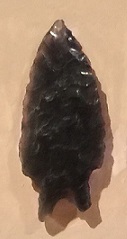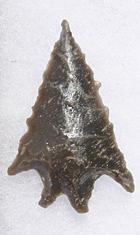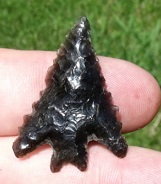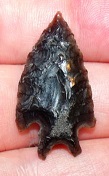Outline is Representative of Size and Shape:

Name Details:
Identifd By: David H. Thomas
Named For: Type Site
Date Identified: 1981
Type Site: Gatecliff Shelter, Nevada.
Identifd By: David H. Thomas
Named For: Type Site
Date Identified: 1981
Type Site: Gatecliff Shelter, Nevada.
Point Validity:
Valid type
Thomas is a distinguished anthropologist who serves as Department Head for the Department of Anthropology, University of Wyoming. He is most noted for his excavations at Gatecliff Shelter in Nevada. This type was named in a professional publication and has many professional references. This is considered a valid type.
Thomas is a distinguished anthropologist who serves as Department Head for the Department of Anthropology, University of Wyoming. He is most noted for his excavations at Gatecliff Shelter in Nevada. This type was named in a professional publication and has many professional references. This is considered a valid type.
Gatecliff Split Stem
AKA: Bare Creek and Surprise Valley
(California, O'Connell)Cluster: Pinto Cluster
Description of Physical Characteristics and Flaking Pattern:
This is a narrow medium triangular stemmed point with a flattened to elliptical cross section. The blade is primarily excurvate, but may vary to straight. The blade is commonly serrated on this point. The shoulders may range from slightly barbed to having an upward angle. The stem may vary from slightly contracting to slightly expanding, but is usually straight. The base is concave forming a bifurcated stem. The flaking pattern may vary from random to parallel oblique.
Size Measurements:
Total Length - 34 to 53 mm (average 42 mm), Stem Length - 6 to 19 mm, Blade Width - 18 to 27 mm (average 24 mm), Stem Width - 11 to 26 mm, Thickness - 5 to 9 mm
Total Length - 34 to 53 mm (average 42 mm), Stem Length - 6 to 19 mm, Blade Width - 18 to 27 mm (average 24 mm), Stem Width - 11 to 26 mm, Thickness - 5 to 9 mm
Commonly Utilized Material:
Additional Comments:
These points use to be included in the Pinto type.
The Gatecliff Split Stem predates the Elko Eared, but they appear to be a continuum of technology (Justice, 2002). This point may be an intermediate between the two types, or this point may represent variations within the two points and not an separate type. Landon (2005) distinguished Elko Split Stem from Gatecliff Split stem based on the basal terminations. He states that the Gatecliff Split stem has a straight stem and sharp basal terminations while the Elko Split Stem has rounded basal terminations.
James O'Connell (1971) identified this type as Bare Creek based on examples from King's Dog and the Rodriguez sites from the Surprise Valley in California. James O'Connell re-analyzed the projectile points from Surprise Valley in 1994 classifying all projectile points as Gatecliff and mot mentioning Bare Creek or Surprise Split Stem projectile points. The Surprise Valley projectile points were differentiated by barbed shoulders.
These points use to be included in the Pinto type.
The Gatecliff Split Stem predates the Elko Eared, but they appear to be a continuum of technology (Justice, 2002). This point may be an intermediate between the two types, or this point may represent variations within the two points and not an separate type. Landon (2005) distinguished Elko Split Stem from Gatecliff Split stem based on the basal terminations. He states that the Gatecliff Split stem has a straight stem and sharp basal terminations while the Elko Split Stem has rounded basal terminations.
James O'Connell (1971) identified this type as Bare Creek based on examples from King's Dog and the Rodriguez sites from the Surprise Valley in California. James O'Connell re-analyzed the projectile points from Surprise Valley in 1994 classifying all projectile points as Gatecliff and mot mentioning Bare Creek or Surprise Split Stem projectile points. The Surprise Valley projectile points were differentiated by barbed shoulders.
Distribution: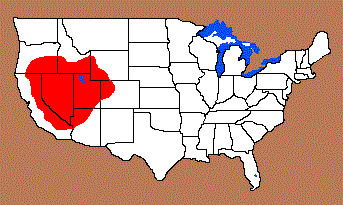
Distribution Comments:
This point is primarily found through out the Great Basin and extend east to the Colorado River and extend down the Colorado River to California.
This point is primarily found through out the Great Basin and extend east to the Colorado River and extend down the Colorado River to California.
Age / Periods:
Date: 5,000 - 3,000 B.P.
Cultural Period:Middle to Late Archaic
Glacial Period: Middle Holocene to Neoglacial
Culture:
Date: 5,000 - 3,000 B.P.
Cultural Period:Middle to Late Archaic
Glacial Period: Middle Holocene to Neoglacial
Culture:
Age Details:

